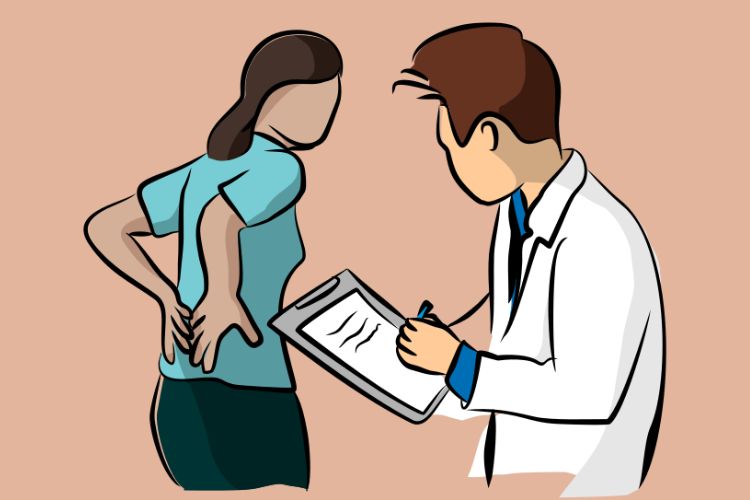It is estimated that as many as 80 percent of adults will experience back pain during their life. For some people, back pain is chronic and persistent, and an incredible intrusion into their quality of life. It can go on for years if the correct diagnosis has not been made and the proper treatment applied. Back pain can change your life if it goes on too long. It results in lost work, and loss of interest in everyday activity, and can place a strain on everything you do. When you have back pain and fever, the problem is worsened as you could be dealing with a much more serious condition.
Infection is the most common cause of fever and back pain. This is most commonly found in low back pain with fever. Lower back pain and fever can be caused by a number of conditions such as kidney or bladder problems, spine infections or disease, or injury. Lower back pain and fever can be treated and is among the easiest kinds of back pain to treat. If you are dealing with back pain and fever, or chronic back pain, use this guide to learn more about the symptoms, causes, and medical or at-home treatments for back pain and fever.
Causes of Back Pain and Fever
There are many different causes of back pain and fever. Infection in the kidneys or bones is the most common cause of back pain and fever. Pyelonephritis is a kidney infection that can cause low back pain and fever. Osteomyelitis is a bone infection that can also cause lower back pain and fever and chills. When you have lower back pain and fever for more than a few days, it is critical to get a medical diagnosis. This kind of pain is not pain that you can let go on too long.
The most common causes of fever and lower back pain are infection and injury:
- Osteomyelitis
- Pyelonephritis
- Injuries or damage to the muscles or underlying tissues
- Infection, inflammatory disease, and illness
Treatment is necessary for chronic back pain or back pain and fever. If you have an infection that is causing back pain, you will need treatment as soon as possible. Infections left too long without treatment will result in worsened conditions. You could get sicker.
For other kinds of back pain, persistent pain will negatively impact the quality of your life and could result in more extensive injury. Seek a doctor when you have back pain and fever that has gone on for more than a few days and is not responding to at-home remedies for fever and back pain.
Pyelonephritis is a kidney infection and is one of the most common causes of fever and back pain. Your doctor will check for this first. This can start with a simple urinary tract infection and result in something more serious. When you begin having pain here, contact a doctor for immediate treatment.
Osteomyelitis is a bone infection that can start anywhere in your body. If it begins in your spine, you will experience back pain and fever. You may have osteomyelitis if you have lower back pain and fever and have recently had spinal surgery.
Sepsis, or septicemia is a serious infection of the blood that could be fatal. You can get sepsis from any minor treatment or surgery. Even a dental visit could result in sepsis. If you have lower back pain and fever and chills, seek immediate medical attention.
In some cases, injury or damage to the muscles or tissue can result in fever and back pain. If you have repetitive injuries, this damage may cause lower back pain and some fever. While it may seem unusual to get a fever after an internal injury, it is not an unusual instance for a doctor. A fever is the body’s response to a problem in the body. When your body temperature changes, or rises as a result of internal injury, your body is telling you something. If you have recently injured yourself and experience a fever, talk to your doctor about the fever and back pain as soon as you can.

Other less common causes that cause back pain and fever include:
- Disk issues in the spine – degenerated, ruptured, bulging disks
- Arthritis
- Bursitis
- Sciatica
- Cancer of the spine
- Spinal infections
Back pain is a serious problem that will interfere with your life. Understand your symptoms and talk to your doctor if you are struggling.
Understanding the Symptoms
Back pain and fever or lower back pain and fever and chills are serious symptoms. However, these aren’t the only symptoms you will experience when you have back pain. There are as many different kinds of symptoms with back pain and fever as there are causes of back pain. Every kind of cause of back pain will result in different kinds of symptoms. Pay attention to your body and make note of your symptoms. If anything seems unusual for too long, let your doctor know.
When your muscles or back have been in pain for more than a few days or longer than a week, it is important to make note of the symptoms. If you have recently had an injury or have engaged in physical activity that caused back pain, you will often know what the cause of your pain is. Still, noting that the pain has gone on longer than what feels normal is a symptom. Minor injuries will heal on their own, it is the job of the human body to do this. For those that do not, you will need medical attention.
When an infection or fever and back pain from an injury has been left too long, you might experience damage to the organs. A simple kidney infection could result in kidney damage which could be life-altering. Chronic back pain and fever, or lower back pain with fever and chills is a serious symptom that needs medical attention. When the pain lasts longer than six weeks, and you haven’t seen a doctor, book an appointment to get some help.
The kind of fever that you have is also a symptom of lower back pain and fever. Mild or low-grade fevers that are lower than 100 degrees Fahrenheit are usually easily treated and can be managed on your own. If your fever is over 102 degrees Fahrenheit, it can be a symptom of a serious infection or problem. A fever that is this high can not go on for more than a few days without medical help.
Other symptoms of fever and back pain include:
- Constant dull pains in your lower back
- Stabbing pains that go through your leg to your foot
- Having difficulty standing for more than a minute or two without pain
- Problems walking
- Pain that restricts your normal body movements
- Muscle spasms
- Pain that lasts more than two weeks
You can treat back pain and fever at home. In some cases, you should seek medical attention as soon as possible. Do not let fever and back pain interfere with your life for too long.
Treatment Options
There are many different ways to treat back pain and fever. In most cases, lower back pain and fever, or lower back pain and fever and chills can be treated with acetaminophen and antibiotics. Non-steroidal anti-inflammatories (NSAIDs) such as ibuprofen can be taken as well. Most of these medications can be purchased over the counter and will treat both the pain and the fever simultaneously. When your back pain is more severe, you may need more intensive or invasive treatment.
Medication can be prescribed when your pain is chronic and persistent. Medication with opioids can help to manage pain. Other medications such as gabapentin can help to control the nerves that are causing back pain.
There are other ways that you can treat back pain as well. Rest and a retreat from regular activity will help to treat your back pain. Many doctors will say that too much rest, particularly after an injury, may be counterproductive. Give your muscles and tissues some time to rest. More than a few days in bed could prevent your muscles from healing.
For back pain that is chronic or causes serious fever, medical intervention can get more serious. There are some surgeries to correct disks or other spinal issues. This will treat your pain. Electrothermal therapy is another common way to treat pain without the invasive intervention of surgery.
Every kind of back pain is different. As such, it is important for your treatment plan to be unique to you. This comes with the proper diagnosis and a plan with your health team.
Home Remedies and Self-Care Tips
Back pain and fever can be managed at home. There are many different things that you can do to treat your back pain and fever.
Exercise feels counterintuitive when you have lower back pain and fever. It feels like it hurts too much. However, this can release pain-relieving endorphins that help you to heal, and help you to feel better. When you can get your blood pumping and flowing to damaged tissues, it speeds up healing in most cases.
The old method of RICE helps to bring self-care to back pain and fever at home as well. Rest, apply ice, apply the compress to the area, and elevate the body part that needs healing when you can. Do not sleep on your back if you can avoid it. Practice maintaining good posture.
When to Seek Medical Attention
Most adults will not seek medical attention for minor injuries or back pain and fever that just began. You may not even notice that you have a fever with your back pain. A good general rule of thumb is to seek medical attention when your pain has gone on too long or your fever does not respond to at-home treatment of acetaminophen or ibuprofen.
If the pain that is causing fever appears to radiate or move down your body into your legs or up your spine, this is pain that needs attention. You may also feel weakness in some area of your body. This is another symptom that your doctor will want to know about.
Chronic and persistent fever is more serious in many cases than chronic pain. You may have a fever that goes up and down throughout the day, and this may feel normal to you. It is not. If your fever spikes or lasts too long, seek emergency or medical attention as soon as you can.
Prevention of Back Pain and Fever
Prevention of lower back pain goes a long way. To prevent back pain and fever, take care of yourself and your body. Make healthy choices whenever you can in your life, exercise regularly, and ensure you have good hygiene. Take the steps that you need to optimize the health of your immune system so that you don’t have to think too hard about preventing back pain.
That can include bringing more vitamins into your diet, eating or consuming antioxidants that dispel free radicals from your blood, and eating healthy. Regular exercise and good posture go a long way. Exercise can help you to keep a healthy weight and can strengthen your muscles and make you more flexible physically overall.
End Back Pain and Fever
Back pain and fever or lower back pain and fever are serious symptoms that need to be addressed. Talk to your doctor immediately if these symptoms go on for too long. Take measures at home to take care of yourself and treat the symptoms on your own. Bring more healthy habits into your daily life to ensure you can prevent back pain and fever from recurring or coming back. Back pain and fever can be debilitating, but it can also always be treated.
